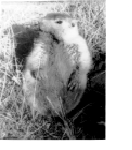
Distribution. Mongolia, Manchuria, Transbaikal.
Tarvaga are active about six months a year but it still takes at least three years to mature and presumably disperse. About half the females breed in a given year and litter sizes are small, averaging 3-4 pups (although at one study site, litters averaged 7 pups!). They have a single alarm call, but there is also individual variability. Mongolians prize their meat and oil, and export their fur to Russia. Hunting tarvaga is a major pastime and according to Dr. Batbold, a Mongolian marmot expert, managing hunting will prove to be a challenge in the future. Hunters shoot them from horseback and camouflage themselves with large "bunny-like" ears and also "dance" and wave a white yak-tail to get the marmots to stand up and be more easily shot. Marmots in some parts of Mongolia are subject to plague. Interestingly, Dr. Batbold's research has shown that plague-resistant populations have a higher body temperature. Tarvaga have a single alarm call, reminisent of their close relatives (M. bobac and M. babacina).
